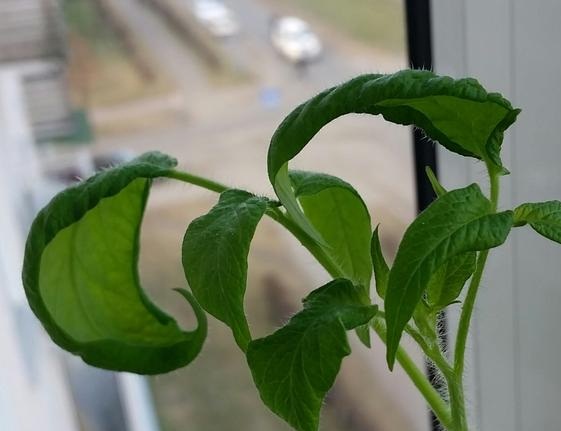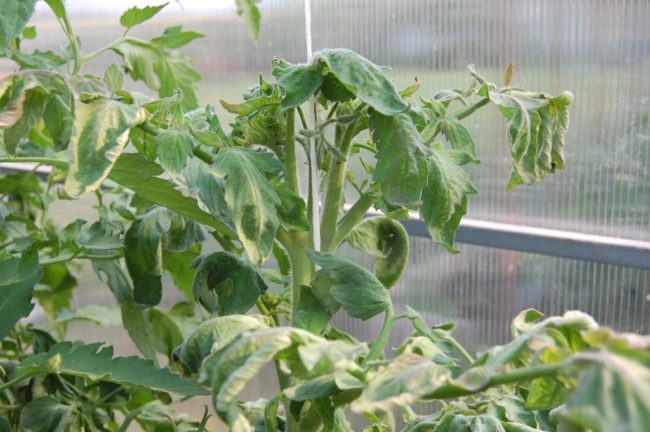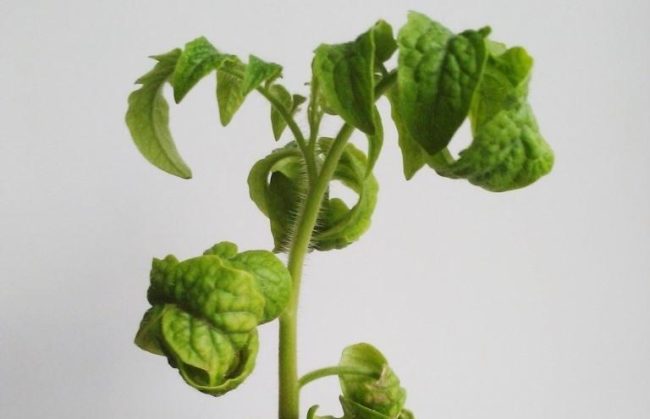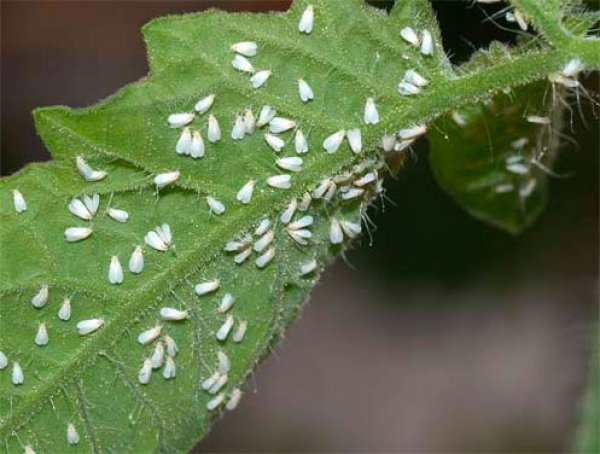Why leaves of seedlings are bent inwards?

Problems with tomato seedlings can be many. Often a person notices that the leaves of the culture are twisted inside.
This is an alarming signal, as it may indicate a violation of the rules of cultivation or a serious disease, which can destroy the entire future harvest.
Causes of the problem
 If you do not ensure proper care of the seedlings of tomatoes, you can meet with such a phenomenon as the twisting of the leaves down or inwards. If you observe your actions, remember the peculiarities of the conditions of culture germination, you can quickly understand what led to this state.
If you do not ensure proper care of the seedlings of tomatoes, you can meet with such a phenomenon as the twisting of the leaves down or inwards. If you observe your actions, remember the peculiarities of the conditions of culture germination, you can quickly understand what led to this state.
The main reasons include:
- increased temperature;
- improper watering;
- lack of nutrition;
- pests;
- seedling disease.
All the problems presented can be divided into groups: violations of agricultural technology, diseases and pests.
Improper care
Often twisting the foliage down is caused by a banal violation of the rules of care. If you correct these points, you will be able to restore the plants, as well as get the proper harvest.
Wrong watering
Foliage tomato can twist with a lack and an excess of moisture. With insufficient watering, the plant tries to survive, the moisture begins to evaporate at a slower rate, which leads to a twisting in the form of boats inside. To restore the plant will help frequent watering, but water should be poured a little bit.
But overflow will also cause leaves to curl, but in this case the edges are wrapped up.
High temperature
 Very often, due to high heat loss of trace elements occurs inside the plant. Therefore, it loses its strength, the foliage dries, coagulates.
Very often, due to high heat loss of trace elements occurs inside the plant. Therefore, it loses its strength, the foliage dries, coagulates.
The premises will help regular airing. A person can help restore a weakened plant. To do this, it can be sprayed with a solution of urea (1.5 tablespoons per 10 liters of water). After a few days, the culture was treated with a weak solution of potassium permanganate.
Incorrect dressing
Sometimes seedlings lack fertilizer and various trace elements in the soil. As a result, the leaves curl edges. By characteristic signs, it is possible to determine which substance is necessary:
- with a lack of boron leaves twist, brighten;
- with a shortage of zinc, not only the foliage but also the tip bends down;
- deficiency of copper and sulfur leads to foliage twisting;
- the absence of potassium causes a color change to pale, curling;
- with a lack of iron, the leaves become very thin and sag, and the edges curl up.
An excess of some components can cause twisting:
- an excess of zinc is manifested not only by curling the leaves, but also by the appearance of a violet hue;
- with a large amount of boron, the edges begin to dry;
- with an excess of nitrogen foliage wrapped inside, but the stem remains green and strong.
On these grounds it is easy to determine which of the elements should prevail during the next feeding.
Pest damage
 Often the seedlings change externally (dry, covered with spots, leaves curled) if insect pests have settled on it. They not only eat tomato juice, they can become carriers of various diseases from bush to bush.For tomato seedlings, the danger is:
Often the seedlings change externally (dry, covered with spots, leaves curled) if insect pests have settled on it. They not only eat tomato juice, they can become carriers of various diseases from bush to bush.For tomato seedlings, the danger is:
- whitefly;
- aphid;
- spider mite.
When the presence of parasitic insects is detected, seedlings should be treated with special preparations (Biotlin, Alatar, Fufanon, and others). Also effective are folk methods: an infusion of onion peel and gruel, an infusion of marigolds and others. The treatment is carried out by spraying.
Diseases
As a result of improper care of the tomatoes, the appearance and development of various diseases can appear, which initially manifest themselves by changing the shape of the leaves. And if in addition there are also pests, then the spread of the disease passes rapidly.
A very dangerous disease, one of the signs of which is twisting the foliage inside, is bacterial cancer. With this problem, there are also other characteristic features:
- lower leaves drawn out;
- gradually the color of the plant fades, and the leaves and shoots begin to dry;
- cracks and ulcers form on the stem and petioles;
- when cut inside the stem, a brown spot is clearly visible.
Bacterial cancer cannot be treated. Affected tomato must be removed and destroyed so that its remnants do not fall into the soil or mulch. For preventive purposes, the remaining healthy seedlings are treated with copper oxychloride solution (40 g of the drug is diluted in a liter of water).
Improper care can lead to the spread of the disease to other bushes. If the affected parts of the plant are not removed, but left on the ground near healthy tomatoes, the virus or fungus will quickly spread to the rest of the bushes.
Not every time leaves that curled down, indicate a disease or problem that requires complex treatment. Sometimes it is just a failure to follow simple rules of care, which is solved very quickly and does not affect the quality and timing of the harvest.

